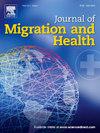Providing continuity of care for people living with noncommunicable diseases in humanitarian settings: A qualitative study of health actors' experiences in Lebanon
IF 2.9
Q1 PUBLIC, ENVIRONMENTAL & OCCUPATIONAL HEALTH
引用次数: 0
Abstract
Objective
The burden of non-communicable diseases (NCDs) is increasing among populations living in humanitarian settings. Continuity of care (CoC) involves following an individual over time and across different levels of healthcare (management, longitudinal, informational and interpersonal continuity); it is an essential component of good quality, person-centred NCD care. Providing CoC is particularly challenging in humanitarian crises where health care access may be interrupted or restricted. This paper aimed to explore health actors’ experiences of continuity of hypertension and diabetes care for Syrian refugees and vulnerable Lebanese in Lebanon.
Methods
We conducted 20 in-depth qualitative interviews with health actors, including eleven with health care providers at four urban-based health facilities supported by international humanitarian agencies that provide NCD care to Syrian refugees and vulnerable Lebanese, one representative of a governmental institution, one international delegate and seven humanitarian actors. Thematic analysis, combining inductive and deductive approaches, was guided by a conceptual framework for NCD models of care in humanitarian settings. We reported our findings against the conceptual framework's domains relating to health system inputs and intermediate goals, reflecting on their impact on the domains of CoC.
Findings
Existing health system weaknesses and novel challenges (the economic crisis, COVID-19 pandemic and Beirut blast) to continuity of NCD care were identified. Health system input challenges: governance and financing (weakened governance, limited central financing, historical dependence on local NGOs for primary healthcare, a dominant private sector), health workforce (exodus of health care providers from the public system), inconsistent medicines and equipment supplies, and limited health information systems (no unified system across institutions or levels of care, lack of formal referral systems, and inconsistent facility-level data collection) contributed to limited public primary care, poorly integrated within a fragile, pluralistic health system. These factors negatively impacted the intermediate health system goals of access, standardisation and quality of NCD care for Syrian refugee and Lebanese patients, and collectively hampered the management, longitudinal, informational and interpersonal continuity of NCD care in Lebanon.
Conclusion
We recommend that humanitarian actors continue the work underway with the Lebanese Ministry of Public Health to align with and strengthen health system inputs, including supporting health governance through the accreditation process, exploring new funding mechanisms, strengthening the workforce via task sharing and training, supporting the medication supply chain, improving access to facilities and service quality, and supporting the development, standardisation and interoperability of referral and information systems. In combination, these elements will support better CoC for people living with hypertension and diabetes in Lebanon.
在人道主义环境中为非传染性疾病患者提供持续护理:对黎巴嫩卫生工作者经验的定性研究
目标生活在人道主义环境中的人群患非传染性疾病(NCDs)的负担日益加重。连续性护理(CoC)是指在不同的医疗保健阶段(管理、纵向、信息和人际连续性)对个人进行长期跟踪;它是以人为本的优质非传染性疾病护理的重要组成部分。在医疗服务可能中断或受到限制的人道主义危机中,提供连续性尤其具有挑战性。本文旨在探讨医疗人员在为黎巴嫩境内的叙利亚难民和弱势黎巴嫩人提供高血压和糖尿病护理的连续性方面的经验。方法我们对医疗人员进行了 20 次深入的定性访谈,其中 11 次访谈的对象是由国际人道主义机构支持的、为叙利亚难民和弱势黎巴嫩人提供非传染性疾病护理的四个城市医疗机构的医疗服务提供者、一名政府机构代表、一名国际代表和七名人道主义人员。专题分析结合了归纳法和演绎法,以人道主义环境下的非传染性疾病护理模式概念框架为指导。我们根据概念框架中与卫生系统投入和中间目标相关的领域报告了我们的研究结果,并反思了它们对共同核心领域的影响。研究结果确定了现有卫生系统的薄弱环节以及非传染性疾病护理连续性面临的新挑战(经济危机、COVID-19 大流行病和贝鲁特爆炸)。医疗系统投入方面的挑战:治理和融资(治理薄弱、中央融资有限、初级医疗历来依赖当地非政府组织、私营部门占主导地位)、医疗队伍(医疗服务提供者离开公共系统)、药品和设备供应不稳定、医疗信息系统有限(各机构或各级医疗机构之间没有统一的系统、缺乏正规的转诊系统、设施一级的数据收集不一致),这些因素导致公共初级医疗服务有限,未能很好地融入脆弱的多元化医疗系统。这些因素对卫生系统的中期目标,即为叙利亚难民和黎巴嫩患者提供非传染性疾病护理的可及性、标准化和质量产生了负面影响,并共同阻碍了黎巴嫩非传染性疾病护理的管理、纵向、信息和人际连续性。结论我们建议人道主义行动者继续与黎巴嫩公共卫生部合作,配合并加强卫生系统的投入,包括通过认证程序支持卫生治理,探索新的筹资机制,通过任务分担和培训加强员工队伍,支持药品供应链,改善设施的可及性和服务质量,以及支持转诊和信息系统的开发、标准化和互操作性。这些要素结合在一起,将为黎巴嫩的高血压和糖尿病患者提供更好的社区保健服务。
本文章由计算机程序翻译,如有差异,请以英文原文为准。
求助全文
约1分钟内获得全文
求助全文
来源期刊

Journal of Migration and Health
Social Sciences-Sociology and Political Science
CiteScore
5.70
自引率
8.70%
发文量
65
审稿时长
153 days
 求助内容:
求助内容: 应助结果提醒方式:
应助结果提醒方式:


